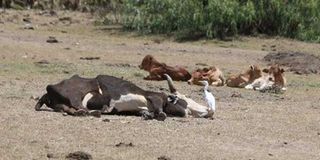Herders seeking pasture in Mt Kenya count losses as animals die

Calves lie next to a dead cow on the Nyeri-Nanyuki road. Herders moving to the Mt Kenya region for greener pastures are counting losses after a disease outbreak killed more than 20 cows. PHOTO | JOSEPH KANYI | NATION MEDIA GROUP
What you need to know:
- The animals are being affected by a bacterial pneumonic disease as they are exposed to harsh weather conditions especially at night.
- Over 20,000 animals have flocked Kieni East in Nyeri due to the ongoing drought.
- The pastoralists have also established semi-permanent houses in Solio Ranch.
Herders moving to the Mt Kenya region for greener pastures are counting losses after a disease outbreak killed more than 20 cows and left others are sick.
More than 15 carcasses of the herd could be seen lying along the Nyeri-Nanyuki road where the herders are grazing their animals.
According to the Nyeri County Executive for Agriculture Robert Thuo, the animals are being affected by a bacterial pneumonic disease as they are exposed to harsh weather conditions especially at night.
“The animals are very hungry and are exposed to extreme harsh weather conditions as the area they are grazing in is extremely cold and windy at night.
“These are factors that trigger pneumonic pasteurellosis for both cattle and small stock,” he said.
20,000 ANIMALS
Statistics by the National Disaster Management Authority in Nyeri show that over 20,000 animals have flocked Kieni East in Nyeri due to the ongoing drought.
The pastoralists have also established semi-permanent houses in Solio Ranch.
The Kenya Veterinary Association disease control programme coordinator Mwangi Gichomo called for an inter-county government collaboration on how to mitigate the drought menace.
“Each county that has pastoralists migrating to other counties needs to contribute financially for mitigation of diseases,” he said.
BLUE TICKS
He said the animals are heavily infested with blue ticks and that the county has not set aside funds to counteract the effects on its own animals.
“This calls for recharging of our cattle dips but the county can only manage to treat three cattle dips of the six dips along the forest zones and livestock routes in the county with acaricides,” he said.
The county has so far vaccinated animals against foot and mouth disease, sheep and goat pox, contagious caprine pleura pneumonia, enterotoxaemia, rabies, lumpy skin disease and blanthrax.
“Although the animals have not brought in new diseases, we are cautious because we do not know the precaution the host counties had administered to their animals,” said Dr Gichomo.





